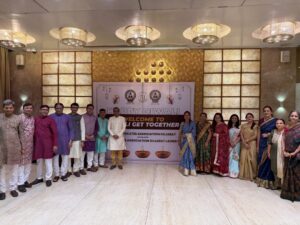GST WEEKLY UPDATE : 25/2022-23 (18.09.2022) By CA Vipul Khandhar

-By Vipul Khandhar
- Updated version of e-Invoice QR Code Verify Mobile App. is available:
- A Quick Response (QR) code needs to be mandatorily displayed on all B2B invoices issued by businesses for whom e-Invoicing is applicable. This QR code is a two-dimensional barcode that can be read by a well-configured QR code reader. The Government has recently released a QR code verification Appthat allows the user to check the authenticity of the invoice received. In this article we’ll discuss about E invoice Verification App, e invoice scanner online, E invoice verification online.
- QR code verify app GST etc. CBIC has made e-Invoicing mandatory for taxpayers/businesses that have an aggregate annual turnover of more than INR 10 crores. As per the e-Invoicing rules, businesses should generate invoices as per the e-Invoice schema on their internal systems and upload them on the Invoice Registration Portal (IRP) for validation. The IRP will verify the details in the invoices uploaded and then digitally sign the invoice and share the e-Invoice with the Invoice Reference Number (IRN) and Quick Response (QR) code with the taxpayer. Further, the taxpayer has to mandatorily include the received QR code in the final invoice shared with the recipient/purchaser.
- If the correct QR code is not included in the final invoice, e way bill qr code scanner online, the e invoice qr code scanner online will be considered invalid. This can lead to heavy penalties.
The QR code consists of these essential invoice parameters:
- GSTIN of supplier
- GSTIN of recipient/buyer
- Invoice number as given by supplier in his/her internal system
- Date of the generation of invoice
- Invoice value (taxable value and gross tax)
- Number of line items.
- HSN Code of the main item (the line item having the highest taxable value)
- Unique Invoice Reference Number (hash)
- Digital signature of IRP
Verification of QR Code.
- As mentioned above, the QR code contains all the vital information that is included in the invoice. Verification of this QR code can help the users authenticate the validity of the invoice. This verification can be done in two ways by using the QR code verification App:
- By Scanning the QR code
- By uploading the JSON
· How To Download And Install The QR Code Verification App?
To download the Einvoice QR code app or QR code verification App:
Step 1: Visit https://einvoice1.gst.gov.in/Others/QRCodeVerifyApp
Step 2: Select the mobile device ‘Android or iOS’ and enter your phone number and click on ‘Submit’. An OTP will be sent to the number.
- On installation of APP, dealer can verify the authenticity of the E invoice.
- CBIC develops System to Monitor GST Audits:
The CBIC has developed a system to monitor of GST audits initiated by tax officials across the country for effective oversight of the audit process.
- E-Way Bill for Gold:
- E-Waybill for Gold will be available only after the notification is issued by Government.
- E-Way Bill generation has been provisioned for movement of Gold (HSN Chapter 71) for all Intrastate and Interstate transactions.
- The taxpayers of the state may generate the E-Waybill for Gold as per the notification issued by their respective states.
- The e-Waybill for Gold is available as a separate option in the main menu. The e-Waybill for Gold has all the same parameters as that of normal e-waybill except that such e-waybills will not be updated with Part-B details.
- The validity of such e-Waybill is calculated based on the pin to pin distance of origin and destination. For generating E-Waybill for Gold it is mandatory that all the items must belong to the HSN Chapter 71 only.
- In case of items belonging to other HSN chapter along with HSN chapter 71 exist, then it may be treated as a normal e-Waybill and may be generated along with Part-B details. The changes in functionalities with respect to e-Waybill for Gold are as follows:
- No Part-B details can be updated
- Transporter update is not allowed
- Consolidated EWB cannot be generated
- Extension of e-waybill is allowed without updating Part-B details
- Multivehicle facility is not allowed
- However, there is no change in cancellation and rejection of e-waybill.
- It has been option at present subject notification of the respective state govt.
- DGFT notified Para 2.54(d) under FTP to permit Invoicing, payment and settlement of exports/imports in INR in sync with RBI’s recent circular:
Para 2.52(d) is introduced as under:
(d) Invoicing, payment and settlement of exports and imports is also permissible in INR under RBI’s A.P.(DIR Series) Circular No.10 dated July 11, 2022. Accordingly, settlement of trade transactions in INR may also take place through the Special Rupee Vostro Accounts opened by Al) banks in India as permitted under Regulation 7 (1) of Foreign Exchange Management (Deposit) Regulations, 2016, in accordance to the following procedures:
(i) Indian importers undertaking imports through this mechanism shall make payment in INR which shall be credited into the Special Vostro account of the correspondent bank of the partner country, against the invoices for the supply of goods or services from the overseas seller /supplier.
(ii) Indian exporters, undertaking exports of goods and services through this mechanism, shall be paid the export proceeds in INR from the balances in the designated Special Vostro account of the correspondent bank of the partner country.
- AAR & Judicial Decisions:
(i) AAR On Printing on Duplex Board job work attracts 12% GST:
(Applicant – Anamika Agrawal)
The West Bengal Appellate Authority For Advance Ruling (AAR), has recently held that Duplex board being a form of paper board, printing on the same falls under Chapter 48 of the Customs Tariff Act, attracting tax @ 12% GST. The ruling resulted from an application made before the AAR by the applicant, under sub section (1) of section 97 of the GST Act and the rules made there under, seeking an advance ruling on applicability of GST rate on works contract (job work).
The question on which the advance ruling was sought, being covered under clause (a) section 97 (2) of the GST Act, it was stated by the applicant that the same was neither decided by, nor pending before any authority under any provision of the GST Act, and that the officer concerned from the revenue hasn’t raised any objection to the admission of the application. Admitting the application, the AAR observed – “To determine the applicable rate of tax on such supply, we first need to decide whether such activities would be regarded as supply of goods or supply of services. Entry No. 3 of Schedule II of the GST Act classifies any treatment or process which is applied to another person’s goods as a supply of services. Here, it is an admitted fact that the applicant carries out printing works on goods (duplex board for the instant case) owned by its customers, and therefore, the activities of printing of duplex board belonging to its customers, would be treated as supply of services. And in the view of the above discussions, we rule that the Supply of services for printing on duplex board belonging to the recipient including cutting, punching and lamination of the duplex board, so printed, would attract tax @ 12%, irrespective of the recipient of the services is registered under the GST Act or not.
(ii) AAR On ITC not eligible to ‘Myntra’ on vouchers & subscription packages procured from third party vendors:
(Applicant – Myntra Designs Private Limited)
The applicant is not eligible to avail the input tax credit, in terms of Section 16 of the CGST Act 2017, on the vouchers and subscription packages procured by the applicant from third party vendors that are made available to the eligible customers participating in the loyalty program against the loyalty points earned / accumulated by the said customers, as the input tax credit is not available in terms of Section 17(5)(h) of the CGST Act 2017.
Disclaimer:
This publication contains information for general guidance only. It is not intended to address the circumstances of any particular individual or entity. Although the best of endeavour has been made to provide the provisions in a simpler and accurate form, there is no substitute to detailed research with regard to the specific situation of a particular individual or entity. We do not accept any responsibility for loss incurred by any person for acting or refraining to act as a result of any matter in this publication.
(Author is a well known Chartered Accountant Practicing in the field of Direct & Indirect Taxes)




